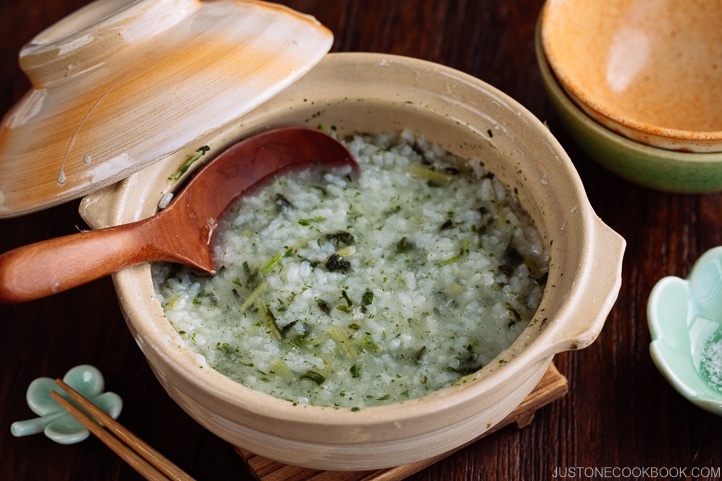
After indulgence of New Year feast during Japanese New Year celebration, Nanakusa Gayu (七草粥) or seven herb rice porridge is enjoyed on January 7 in Japan allowing our stomachs to recover.
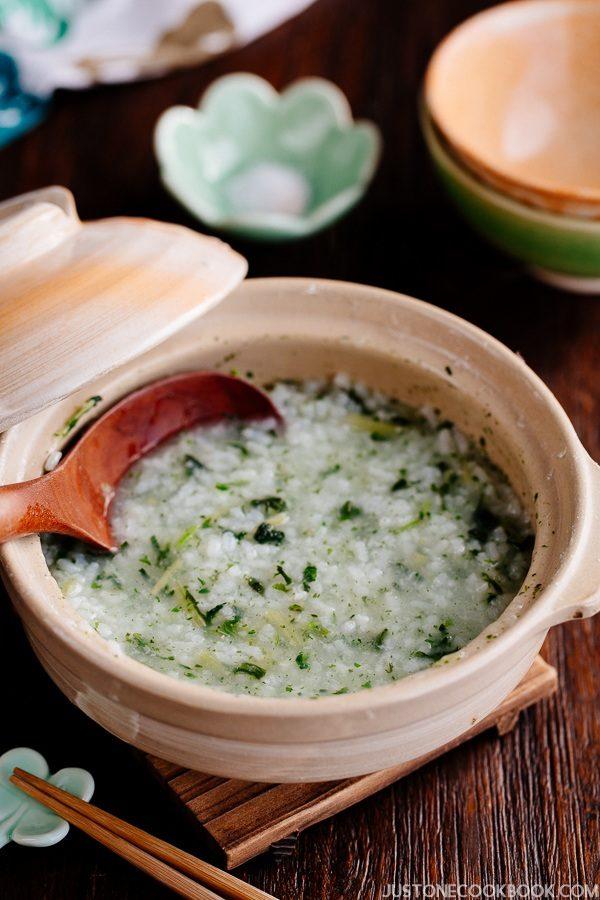
After eating Osechi Ryori (Japanese New Year feast) and all the holiday indulgence, the Japanese eat a healthy light rice porridge on January 7th. The dish is called Nanakusa Gayu (七草粥), and the rice porridge includes seven kinds of herbs. This simple meal hits the spot and helps our tired stomach heal and recover.
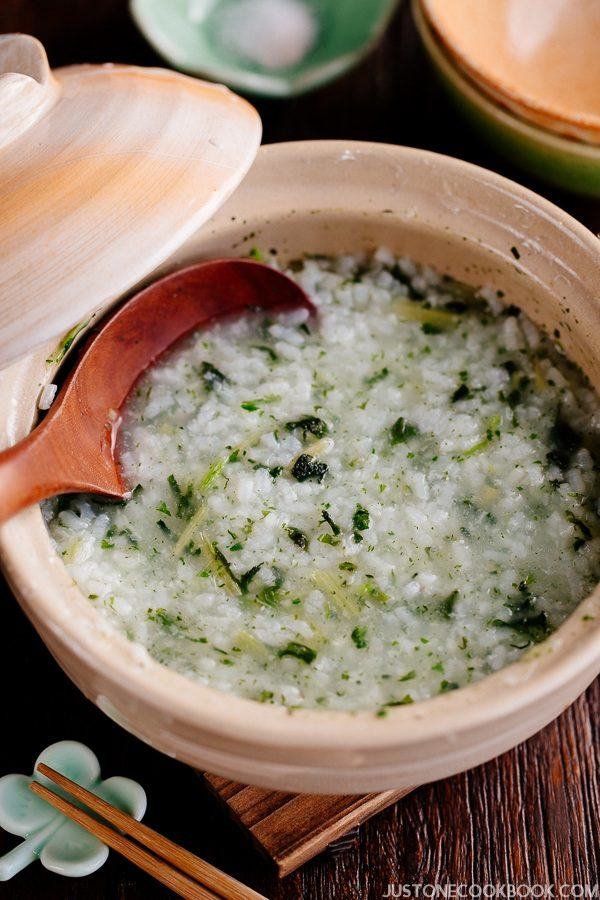
What’s Nanakusa Gayu?
Nanakusa (七草) means seven (= 七 nana) herbs (草 kusa). We sometimes say Haru no Nanakusa (春の七草), which means Spring Seven Herbs, because young herbs that are available at this time of the year are more tender in texture as well as more fragrant, perfect for enjoying with simply porridge.
As we eat rice porridge called Okayu (お粥) when we’re feeling under the weather, we eat rice porridge with seven herbs on January 7th of each year.
January 7th (Jinjitu 人日) is one of the 5 seasonal festivals (節句). The rice porridge is believed to protect from evil and helps prevent illnesses and diseases.
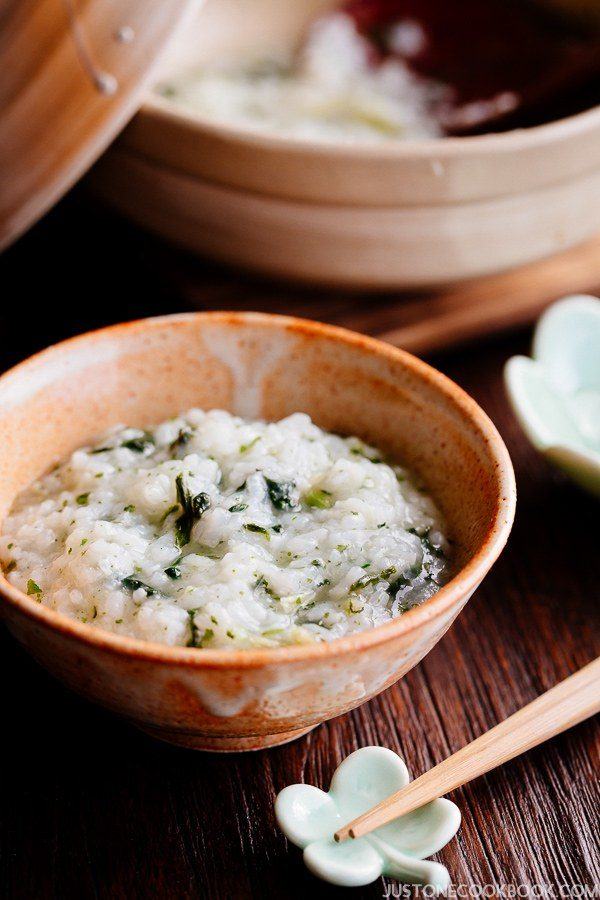
Nanakusa – Seven Herbs
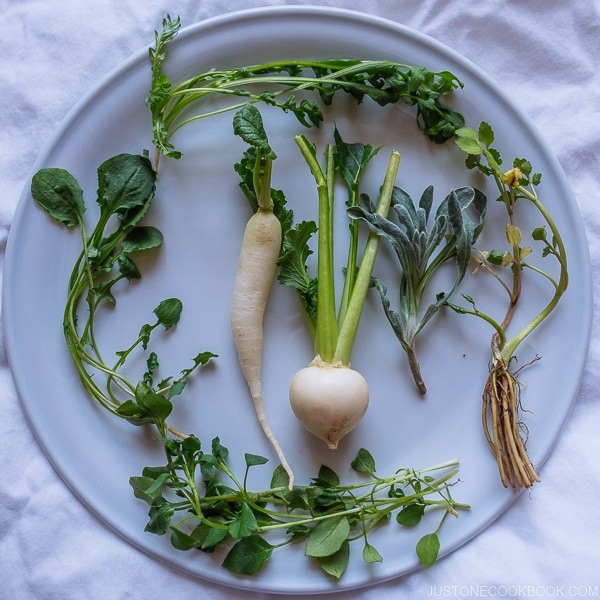
From top, left to right: Hotokenoza (Nipplewort), Hakobera (ChickweedChickweed), Suzushiro (daikon), Suzuna (turnip), Gogyo (Cudweed), Seri (Water dropwort), Nazuna (Shepherd’s Purse)
Here are the seven herbs used in Nanakusa Gayu:
- Seri (せり) / Water dropwort
- Nazuna (なずな・ぺんぺん草) / Shepherd’s Purse
- Gogyo (ごぎょう) / Cudweed
- Hakobera (はこべら) / Chickweed
- Hotokenoza (ほとけのざ) / Nipplewort
- Suzuna (すずな・かぶ) / Turnip
- Suzushiro (すずしろ・大根) / Daikon radish
In Japan, we remember these seven herbs with a song:
「せり なずな、 ごぎょう はこべら ほとけのざ、 すずな すずしろ これぞ七草 (ななくさ)」
“Seri Nazuna, Gogyo Hakobera Hotokenoza, Suzuna Suzushiro Korezo Nanakusa.”
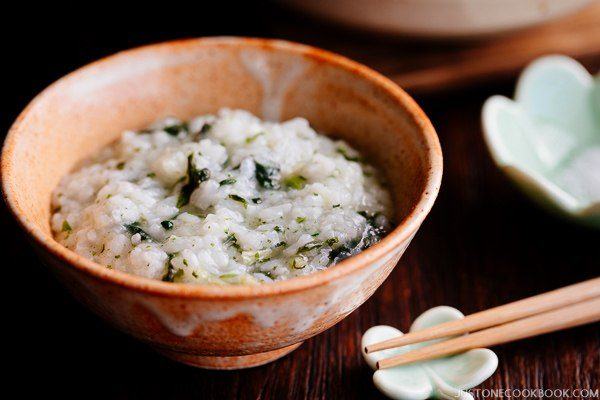
For those of us who live outside of Japan, we can probably find only one or two of the 7 herbs. It’s would be pretty impossible to find all seven herbs. You can choose other herbs that are more common (but not too strong and overkill the other herbs):
- Cilantro
- Basil
- Chervil
- Chives
- Fennel
- Mint
- Watercress, etc
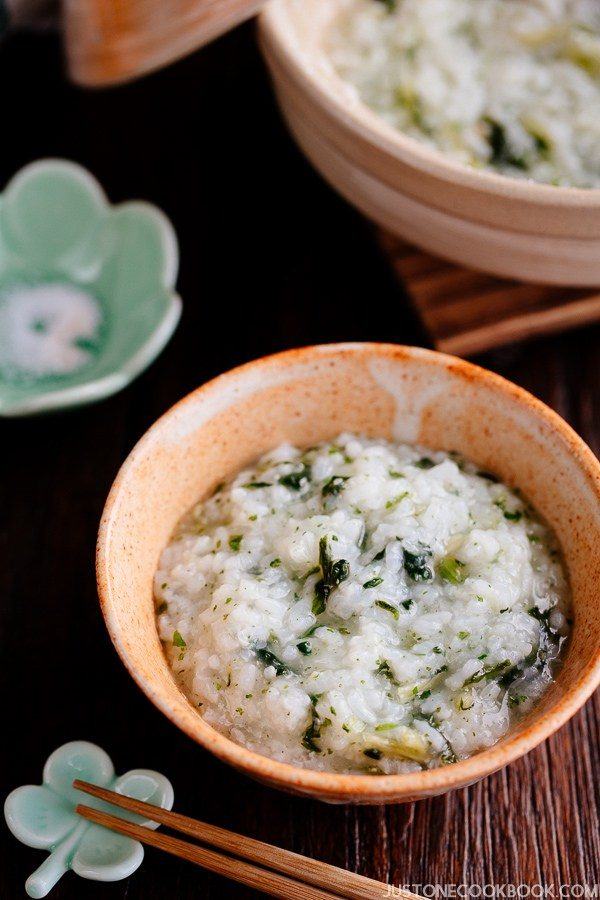
Where To Find Nanakusa Severn Herbs
In Japan:
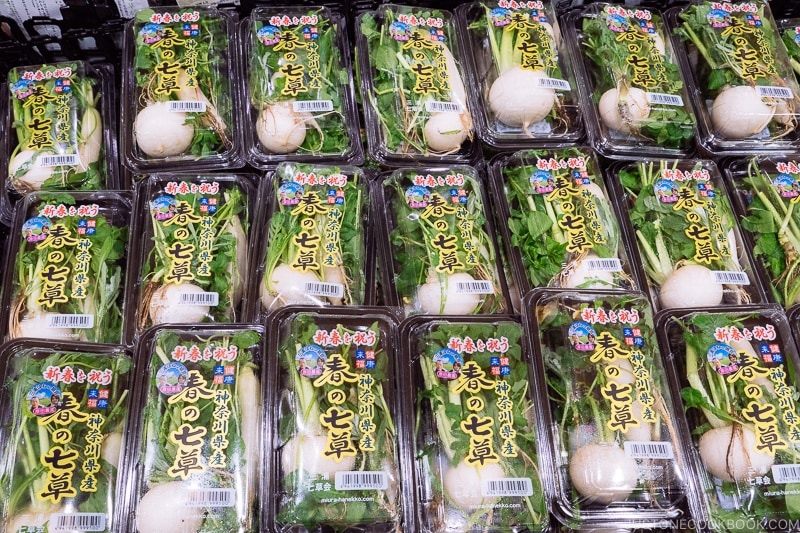
If you go to grocery stores, you can find these packages of convenient “Haru no Nanakusa Set” (春の七草セット).
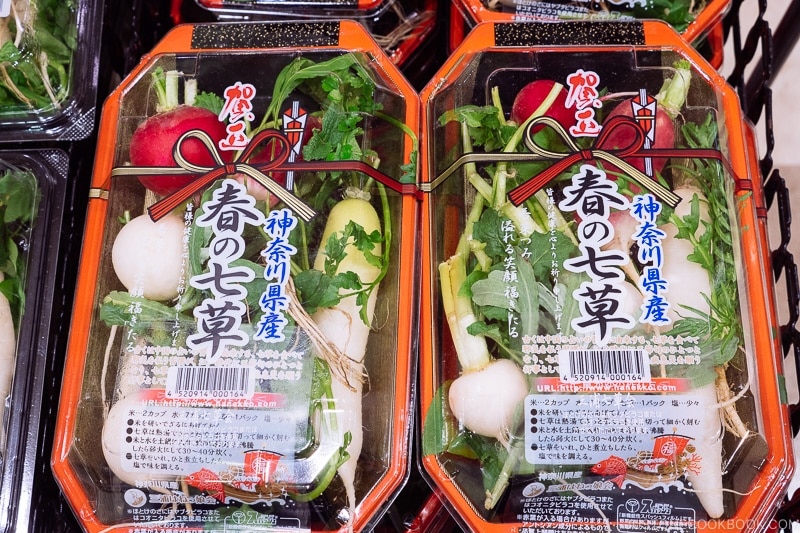
Outside of Japan
If you live outside of Japan, you will most likely have a hard time finding these fresh herbs. I waited for years to share this post on my blog because I simply couldn’t find fresh herbs.
However, this year my local Japanese grocery store Nijiya Market was selling this freeze-dry Nanakusa.
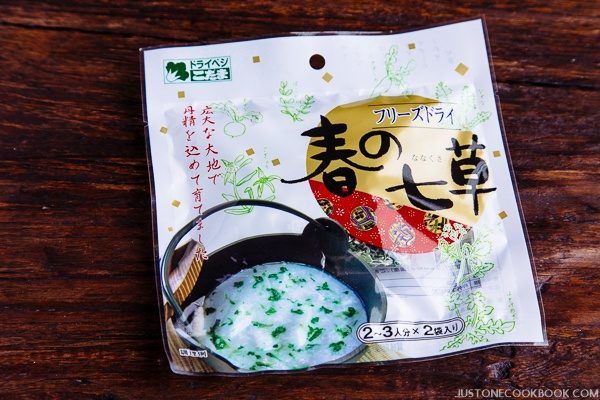
The package includes 2 small servings of freeze dried herbs.
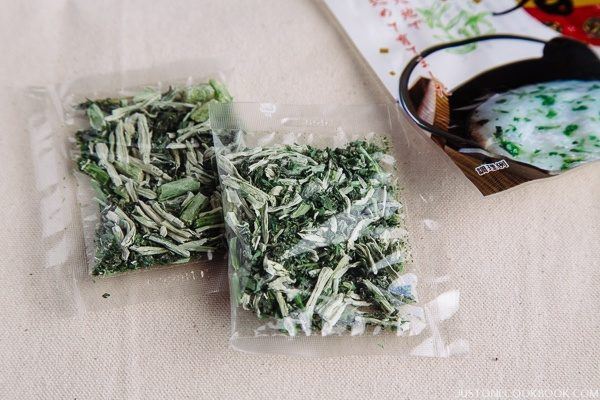
I understand the majority of you will have a hard time finding both fresh and freeze-dried Nanakusa. But I hope you still enjoyed reading about this Japanese custom.
Use Japanese Earthenware Pot Donabe for Nanakusa Gayu
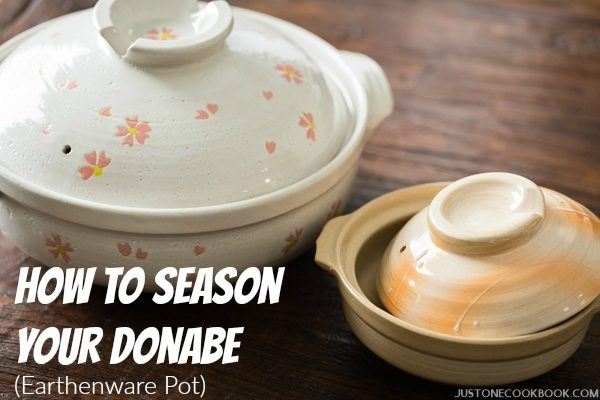
Commonly used for hot pot dishes such as shabu-shabu, Donabe (Japanese earthenware pot) is made of special clay and it’s one of Japan’s oldest cooking utensils. Rice porridge made in Donabe is considered the best and I hope you give it a try.
Before you start using your Donabe, please check this post to learn how to season and care for Donabe.
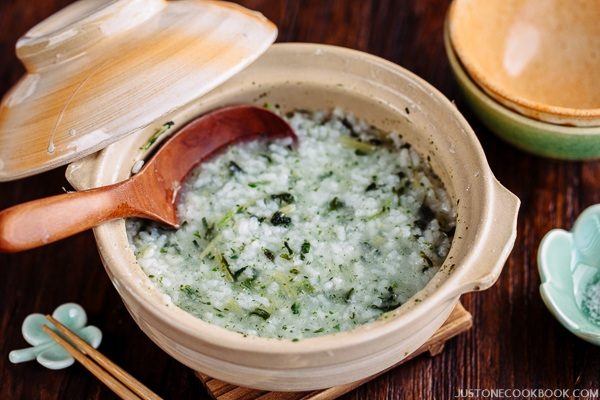
I hope you enjoyed my Nanakusa Gayu post! If you make this recipe, snap a picture and hashtag it #JustOneCookbook. I love to see your creations on Instagram, Facebook, & Twitter! Thank you so much for reading and trying the recipes!
Don’t want to miss a recipe? Sign up for the FREE Just One Cookbook newsletter delivered to your inbox! And stay in touch with me on Facebook, Google+, Pinterest, and Instagram for all the latest updates.
Nanakusa Gayu (Seven Herb Rice Porridge)
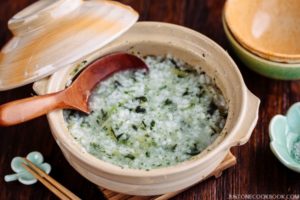
For Rice Porridge
- ¼ cup uncooked Japanese short grain rice ((1/4 cup = 50 g))
- 250 ml water ((250 ml = 1 cup + 1 Tbsp))
- Kosher salt ((to taste))
Nanakusa (Seven herbs)
- 1 package Nanakusa Set (fresh or freeze-dry) ((or 7 herbs of your choice, cut into small pieces))
Make Rice Porridge
- Add 1/4 cup (50 g) short grain rice in a donabe or bowl and rinse under running water while gently rubbing the rice with hands. Repeat until the water runs clear and drain. Soak the rice in the pot for at least 30 minutes and then drain water completely in a strainer for a few minutes.
- Put the rice back in the donabe or pot and add 250 ml of water. Cover the pot and bring to a boil over medium high heat.
- When boiling, lower the heat to the stove’s lowest heat setting (make sure to use the right size of stove burner for your pot size). Open the lid and gently mix with the spoon once, making sure rice is not stuck to the bottom of the pot.
- Cover the lid and simmer the rice for 25-30 minutes. During this time, don’t open the lid or mix the rice (See Note).
- After 25-30 minutes, turn off the heat and let it steam for 10 minutes. The rice should be soft and thickened.
Make Nanakusa Gayu
- Add nanakusa (fresh or freeze-dried) and mix gently. Sprinkle salt to taste. Enjoy!
Use of Fresh Nanakusa: Blanch in boiling water (with pinch of salt) for a few seconds and let cool in iced water to stop cooking. Drain and squeeze water out. Cut into small pieces. If you cook daikon and kabu, cut into thinly slices and blanch till tender and let cool. Then blanch herbs in the same pot.
Use of Freeze-Dry Nanakusa: Read instruction how much freeze-dried nanakusa you will need for each serving.
Cooking Instructions: I follow 1 to 5 rice-to-water ratio for my Okayu recipe. With good size pot, and the lowest heat on the stove, water should not boil over. If you cook with more water or your pot is smaller than my pot, you may want to cover the lid at a slight angle so the water doesn’t boil over. If you are worried, you can quickly peek and make sure there’s enough water so the rice doesn’t burn the bottom of the pot. If necessary, you can stir the pot or add “hot” water. Otherwise, don’t touch the rice because you would end up breaking the nice shape of rice kernels.
Rice-Water Ratio:
Zen-gayu – 1 : 5 (50 grams : 250 ml)
Shichibu-gayu – 1 : 7 (50 grams : 350 ml)
Gobu-gayu – 1 :10 (50 grams : 500 ml)
Sanbu-gayu – 1 : 20 (25 grams : 500 ml)
Using Cooked Rice:
Add rice and 2-3 times water in the pot. Cook stirring over medium low heat. Adjust the consistency by adding more water.
Equipment you will need:
- Small Donabe(earthenware pot)/Heavy Bottom Pot
With the heavy bottomed pot, the heat is not as direct or strong as regular pot, so you can cook rice evenly.
Recipe by Namiko Chen of Just One Cookbook. All images and content on this site are copyright protected. Please do not use my images without my permission. If you’d like to share this recipe on your site, please re-write the recipe in your own words and link to this post as the original source. Thank you.
Editor’s Note: The post was originally published on January 5, 2017. The post has been updated with new images in January 2019.